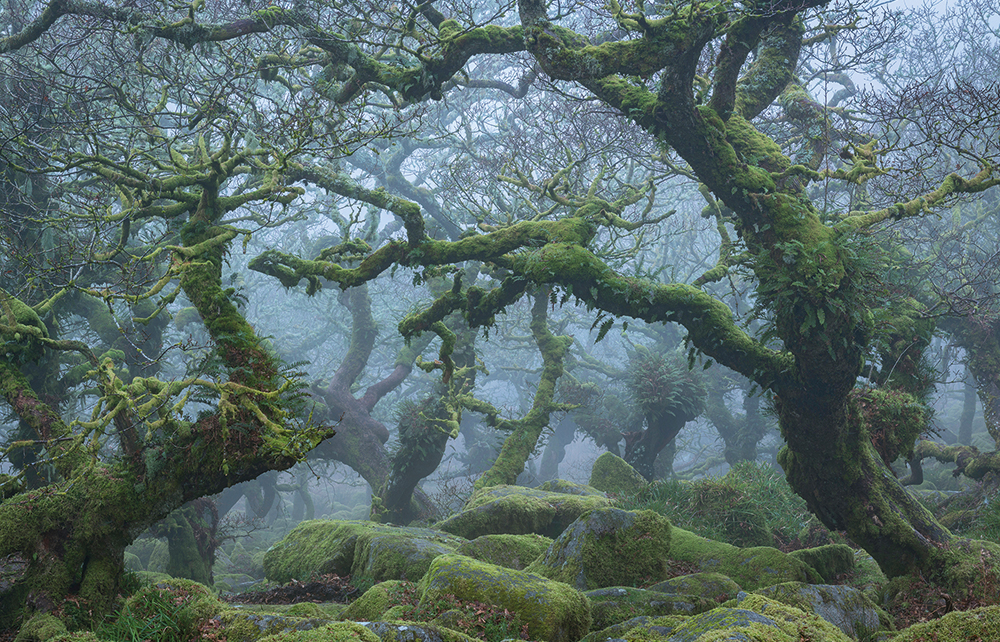One of the most beautiful spots I know in Britain is a steep-sided gorge in Devon where the River Dart carves through the Dartmoor rock on its way to the sea. The trees on either side are small, twisted and covered in ferns, mosses and lichens, so that even on a dull day the colours, shapes and textures are vibrant and dynamic. It was here that I took my wife shortly before she gave birth to our daughter. Nowhere I have been is more utterly beautiful and alive.
This extraordinary place is a fragment of temperate rainforest: a rich assemblage of life made possible by ample rainfall, mild winters and damp summers. Globally, temperate rainforests are rarer than their more famous tropical cousins and are found on the northwest coast of the US and Canada, southern Chile, Tasmania, northwest Europe and a few other places. The western fringes of Britain offer ideal conditions for them to flourish, but today they cover well under one per cent of the island – a tiny part of their historical range. Most of what remains are small patches, and many of these are degraded or disappearing.
A rich assemblage of life was made possible by ample rainfall, mild winters and damp summers
What if the future of temperate rain-forests in Britain could be one not of diminishment and extinction but flourishing resilience? This is the central question of Guy Shrubsole’s book, which may prove to be among the most valuable contributions to the appreciation of, and care for, woodlands in Britain since the work of the great historical ecologist Oliver Rackham in the 1980s.
Shrubsole is an activist as well as an author. Previously a campaigner with Friends of the Earth, he is now a leading member of the Right to Roam, a group pressing for the extension of the Countryside and Rights of Way Act in England, ‘so that millions more people can have easy access to open space’, as they already do in Scotland. His previous book, Who Owns England? (2019), was an investigation into precisely who owns the land in the most populous of the UK nations. Painstaking and systematic, it was also remarkably readable, and whether or not you agree with the author’s politics – he is a self-described ‘green lefty’ – the quality and depth of his research is not in doubt.
The Lost Rainforests of Britain easily matches that book in its rigour and energy. But Shrubsole is also clearly having the best time as he explores remnants of temperate rainforest across southwest England, Wales, the Lake District and western Scotland, and he shares what he learns – not least the extraordinary lichens, ferns and fungi of these unique places – with contagious enthusiasm. Especially revelatory are the maps that he and the cartographer Tim Richards have created for the book, and an associated campaign, which show the roughly 20 per cent of Britain that was once its rain-forest zone and the pitiful scraps that remain.
Is large-scale restoration of temperate rainforest desirable on a small, crowded island at a time when many people cannot afford healthy food? Shrubsole points out that most of land where temperate rain-forest can thrive in Britain is marginal and unproductive for agriculture and grazing, which in any case depends on subsidies that are unlikely to be sustainable. Furthermore, restoration would be ‘not wall-to-wall closed canopy but a mosaic of habitats combining rain-forest with wood pasture, wetland and wildflower meadows’. The net benefits of restoration for human and non-human wellbeing, he argues, would be huge. Britain would also be living up to its principles at home as it calls for protection of tropical rainforests and other endangered habitats abroad.
Is such restoration achievable? Some of the obstacles look formidable, even insurmountable. In Wales, for instance, the campaign group Rewilding Britain, with whom Shrubsole has also worked, ran into implacable opposition from farmers who graze sheep on hills and valleys that might one day be reforested. But Shrubsole suggests a profound irony here, and potential pivot for change. Meetings with Gwyneth Lewis, the first national poet of Wales, and others suggest to him that at its deepest levels Welsh identity and culture was formed by habitats abundant in temperate rainforest. Historically, when Welsh culture was at its most vibrant, grazing and foraging was a matter of some cattle and swine and few, if any, sheep.
In Scotland, the main challenges include excessive numbers of deer (reckoned to have increased from around 100,000 after the first world war to a million today) which eat out young trees; and invasive rhododendron, which crowds out native plants. The former is a huge issue that few seem willing to tackle. The latter is expensive and thankless to address.
But Shrubsole takes heart from the ecologists, activists and others across Britain who are already showing what can be done on a small scale. He is hopeful that a proposal to reconnect fragments of rainforest into a belt along the eastern edge of Dartmoor, significant parts of which are owned by the Duchy of Cornwall, could point the way forward. ‘Restoration,’ he writes, ‘is a multigenerational project’, and we are only just beginning.






Comments